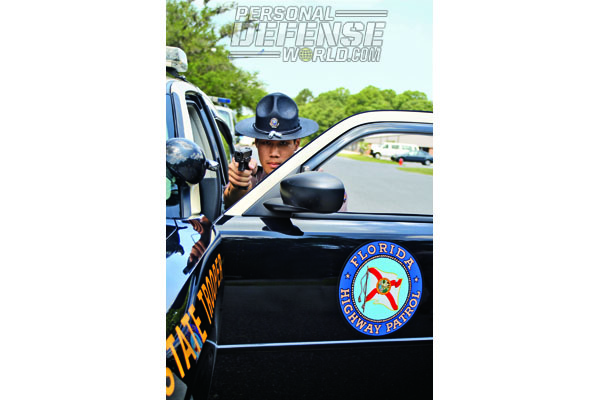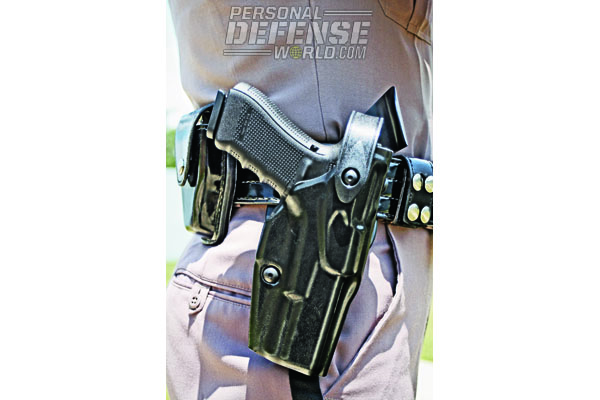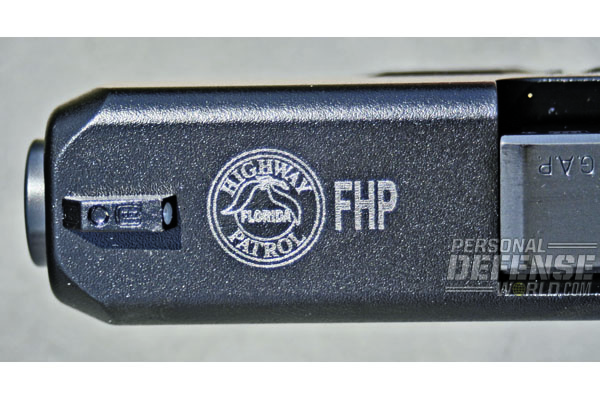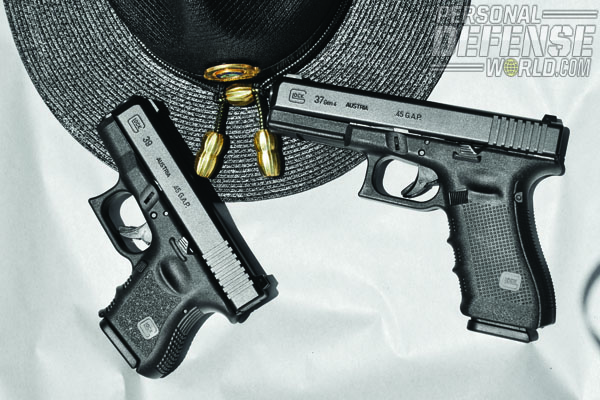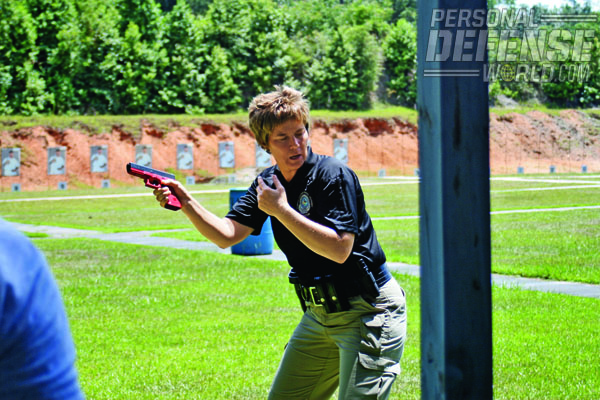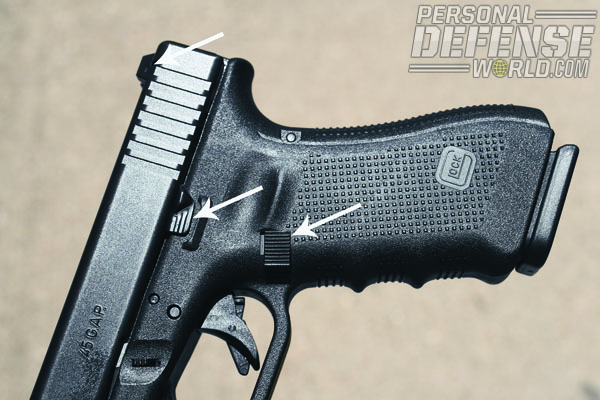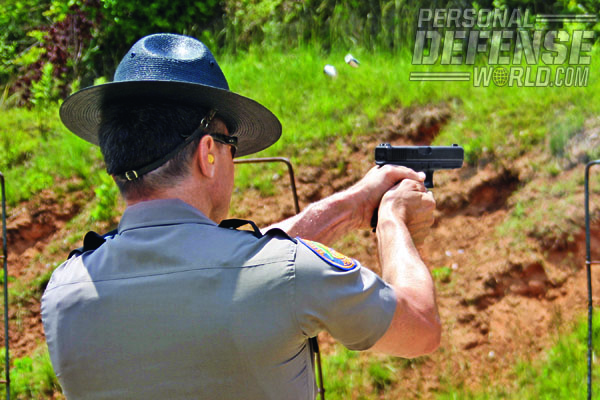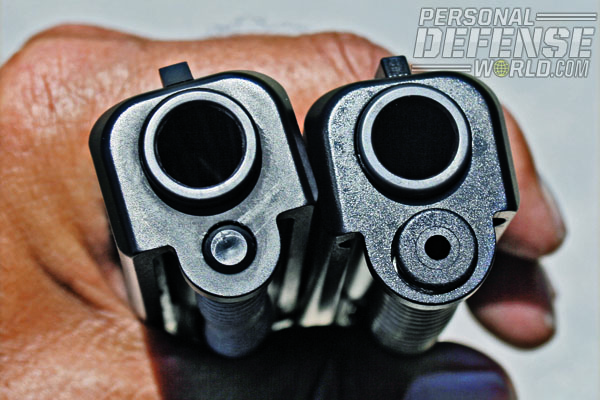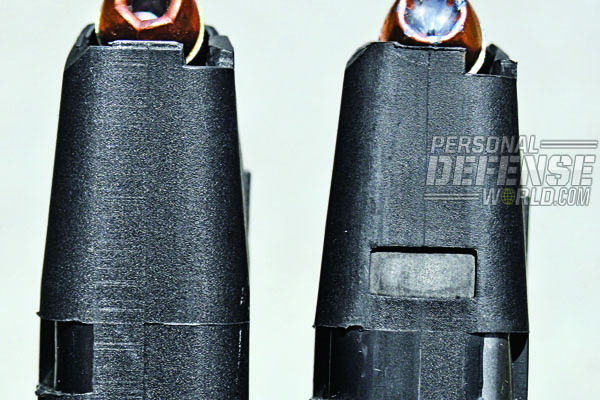The Florida Highway Patrol (FHP) recently became the fifth state law enforcement agency in the nation to adopt the .45 G.A.P., acquiring standard-size GLOCK 37 Gen4 pistols for road troopers and subcompact GLOCK 39 pistols in the same chambering for plainclothes personnel and upper-level supervisors. The transition, which began in second quarter 2010, was the culmination of sixteen months of study and planning.
A Brief History
When the Patrol was founded in 1939 as an arm of the newly created Florida Department of Public Safety, the issue sidearm was the Colt Official Police revolver, caliber .38 Special. Taking into consideration Florida’s humidity and the salt air of its vast coastline, the guns were ordered with nickel plating, a tradition that would continue for decades.
The .38 Special gave way to the .357 Magnum, mostly Colt Troopers and Pythons, though over the years Smith & Wessons would be purchased in K, L and N-frame sizes. The five-inch barrel became something of a trademark of the agency, though some four-inch and six-inch guns were also purchased. For most of this period, the service revolvers were worn cross-draw, butt forward on the left hip, even by left-handed troopers. During the early years, it was common for troopers to adorn their revolvers with pearl or ivory grips bearing the department insignia.
Advertisement — Continue Reading Below
In the mid-1980s, FHP went away from the revolver and adopted the 9×19 Beretta 92F semi-automatic pistol. In the late 1990s, the agency switched to the .40 Beretta 96G. By 2009, Beretta had discontinued that model and FHP only had enough new guns remaining in inventory to outfit two more recruit classes. Many of the weapons in service had sustained more than a decade of use and their night sights were fading. There had also been strong urging from some troopers in the field to go to a more powerful cartridge.
In early 2009, Trooper Melissa Oman, statewide firearms coordinator for the FHP, led a team tasked by deputy director Ernesto Duarte to explore the options available in new duty handguns. Working alongside Academy armorer Jayme Barlow, Oman reached out to major gun and ammunition manufacturers. She also assembled a team of FHP members with a view toward field-testing the possible replacements.
Committee of Peers
The test committee members ranged in rank from civilian armorer to captain and included many troopers but each had an equal voice. Oman was careful to assemble a group that included not only instructors and master shooters but also shooters who had experienced problems mastering the handgun over the years. “We weren’t selecting a pistol for the gun gurus,” Oman told GLOCK ANNUAL. “From the beginning, it was clear to all that we were picking a gun for every sworn member of the Florida Highway Patrol. Ability with the service pistol can be the difference between life and death for any of our people on any given day.”
Advertisement — Continue Reading Below
The committee met multiple times—for a week each time, months apart—to test and evaluate sample firearms in .40 and .45 Auto provided by the various manufacturers. Included were the Beretta Px4, GLOCK, SIG, Smith & Wesson and Taurus models. The first thing that became apparent was that troopers in the field wanted .45 caliber weapons even more adamantly than headquarters had realized. “Early on,” says Oman, “it was clear that we were gearing toward .45s.”
Most of the test guns were chambered for the traditional .45 Auto round, but GLOCK had also sent T&E samples of their .45 G.A.P. models. The .45 GLOCK Auto Pistol (G.A.P.) cartridge was developed in conjunction with ATK/Speer to duplicate .45 ACP ballistics in a cartridge of shorter overall length that would fit a 9×19 or .40 size handgun envelope. This allowed better fit and control in the hands of smaller personnel. The days when all troopers were large males had long since passed; today, some 10% of Florida Highway Patrol’s road troopers are female.
Oman contacted the four state police agencies around the nation which had already adopted the .45 G.A.P.—all in GLOCK 37 pistols—as standard issue for their troopers. These were the New York State Police, Georgia State Patrol, Pennsylvania State Police and the South Carolina Highway Patrol. All four agencies reported that their administrations and their rank and file troopers alike were confident and pleased with their GLOCK 37 .45 G.A.P.s.
Advertisement — Continue Reading Below
“New York has had them for several years,” explains Oman. “They were the first to go with the .45 G.A.P., and they really paved the way. In the second workshop, we brought the Georgia State Patrol down to speak with the Colonel.”
The committee narrowed the choices down to two brands: GLOCK, in calibers .45 Auto and .45 G.A.P.; and Smith & Wesson, with their Military & Police .45 Auto. The final vote came down to the GLOCKS.
Choice of Caliber
Says Oman, “Buford Boone, the head of the FBI Firearms Training Unit, was very helpful and gave us the full benefit of the very extensive wound ballistics testing that the FBI has done. The bottom line came down to, ‘bigger is better.’ We were very comfortable going to a .45 caliber weapon. The only question now was which .45 cartridge.”
Advertisement — Continue Reading Below
ATK put on a ballistics workshop for the committee at the FHP Training Academy, headquartered at the Pat Thomas Law Enforcement Training Center in Tallahassee. The results confirmed the committee’s opinion that the .45 was the direction they wanted to take. It also opened many eyes as to the effectiveness of the .45 G.A.P. round, introduced in 2003, vis-à-vis the .45 Auto cartridge that had been around for more than a century. It was apparent that, on average, the G.A.P. was every bit the equal of the older round: the same performance (and sometimes even slightly better) but in a smaller package.
GLOCK AUTOPISTOLS magazine spoke with Captain Bryan Hudson, a member of the firearm selection committee. “At first, a lot of the gun enthusiasts on the committee were pushing for the GLOCK 21,” he said. “They knew that our sister agency, the Fish and Wildlife Conservation Commission, had recently adopted the GLOCK 21SF and was very happy with it and they didn’t think much of the idea of a shorter .45 cartridge. However, that changed after the ballistics workshop, when they saw the G.A.P. equal and even outperform the bigger cartridge.”
The pendulum slowly but surely swung toward the G.A.P. among the committee members. The impressive performance of the newer round was certainly one reason. But so was the fact that in side-by-side testing, most of the troopers felt the Glock 37 Gen4 was more controllable. Being slightly smaller, it allowed “more hand to get around the gun,” and its bore axis was very slightly lower, an advantage in controlling muzzle jump. Early in 2010, the FHP study group received the first prototypes of the Glock 37 Gen4, which brought the members still more toward the G.A.P. side. The Gen4 pistol has even smaller grip girth and shorter trigger reach, suiting it better for small hands, but still has two backstrap adjustment pieces that can be fitted to tailor the gun to larger hands and longer fingers. Also, the Gen4 comes with RTF (Rough Textured Finish) treatment, which allows better grasp with less slippage.
Advertisement — Continue Reading Below
“Last year, a Fish & Wildlife officer was shot in the gun arm and had to draw and fire weak hand only to save his life,” said one member of the committee. “With your hands slick with blood, you need all the hand traction you can get.” FHP firearms instructor Jason Clark, another member of the committee, called the RTF feature “a must.” Finally, the Gen4 uses a new dual recoil spring, which many who shot it felt gave another little margin of superior control in recoil.
Perhaps the key factor that persuaded committee members toward the G.A.P., however, was the fact that the gun would better fit smaller hands. They had seen it in two weeks of gun testing with a committee that intentionally included some members who were less skilled in shooting than others. The many instructors on the committee had for years wrestled with the problem of teaching troopers with short fingers to master a traditional double-action pistol with a relatively long trigger reach.
The improved dimensions for troopers with smaller hands was a significant factor. However, it was only a piece of the bigger picture. The great majority of those on the test committee, irrespective of hand
size and skill level, had found that the GLOCK 37 Gen4 pistol had simply outperformed everything else. On the final vote, by approximately eighteen committee members, two voted for the GLOCK 21SF. All the rest voted for the GLOCK 37 Gen4 in .45 G.A.P.
Advertisement — Continue Reading Below
The die was cast.
Adoption
The Florida Highway Patrol became the first law enforcement agency in the world to issue the new GLOCK 37 Gen4 pistol as standard. Some 2,500 of the Glock 37 Gen4s were ordered, enough for every trooper, anticipated academy classes and spares. Another 300 GLOCK 39 pistols were ordered for plainclothes and administrative personnel. While the Glock 37 Gen4 is a standard-size service pistol with 4.49-inch barrel and a ten-round magazine complemented by an eleventh round in the firing chamber, the Glock 39 is a subcompact “baby GLOCK” with 3.46-inch barrel and a six-plus-one capacity of .45 G.A.P. cartridges, due to its much shorter grip-frame. All the weapons are laser-engraved atop the slide with the letters “FHP” and the Patrol’s insignia.
“We would have loved to get each trooper a GLOCK 37 Gen4 and also a GLOCK 39 for back-up and off-duty use, as Georgia State Patrol did,” says Lt. Col. Duarte, “but the Florida economy is very tight these days and the budget simply wouldn’t allow it. We did, however, arrange for troopers to be able to purchase their own GLOCK 39s at a very favorable price.” The GLOCK 38 compact .45 G.A.P., in between the other two in size and with eight-plus-one cartridge capacity, is now approved as a personally owned off-duty or backup weapon by the FHP.
Advertisement — Continue Reading Below
The taxpayers of the Sunshine State will hopefully be grateful that FHP was able to work a deal in which their old guns were traded even for the new ones.
Adoption went beyond the pistols in several respects. Many agencies are now authorizing flashlights pre-mounted to the holstered duty gun. FHP is giving this option to each trooper, those who request it will be given a SureFire X300 white light unit and a Safariland 6360 ALS security holster. The rest will be issued an attachable flashlight and a separate duty pouch in which to carry it, along with a standard ALS security holster. Oman says that so far, choice is running about half and half on the flashlights as the new weapons and holsters are issued.
The troopers are also being issued new magazine pouches, a revolutionary Safariland design that holds the magazines with their backs toward the Sam Browne belt and the bullet noses pointed away from the wearer. Debuting originally in IPSC competition, this style of magazine carrier narrows the profile of the magazine on the already-crowded equipment belt and positions it so that the trooper can grab the sides of the mag with thumb and middle finger while using the index finger to release the snap on the protective flap. Troopers will have the choice of a pouch that holds two ten-round Glock 37 Gen4 magazines, or one that holds three. Counting the magazine in the gun and the chambered round, this puts between 31 and 41 rounds at the trooper’s disposal whenever he or she is in uniform. Oman told GLOCK ANNUAL that troopers’ choice is so far running about 50/50 between the double magazine pouch and the triple pouch design.
Advertisement — Continue Reading Below
The agency’s duty ammunition choice was Speer 200-gr. bonded Gold Dot hollowpoint. While 185- through 230-gr. hollowpoints are available, the FHP committee was most impressed with the results of the 200-gr. Gold Dot, both in the ATK workshop and in their own extensive research and testing. This load, Oman points out, has already been street-proven by NYSP and GSP and Captain Hudson adds, “We talked at length with Ernest Durham, the engineer who designed the .45 G.A.P. in cooperation with GLOCK. This is the cartridge that gun was designed to shoot. I’m not surprised that it’s the cartridge that also, in our view, gives optimum performance.”
In addition to the Glock 37 Gen4 and Glock 39 pistols, FHP also acquired some 70 “red GLOCKs,” non-shootable training guns, for issue to academy recruits. These will allow them to safely practice reloads, malfunction clearance, draws, etc. in their dorms. A total of 43 of those guns are engraved with the names and end-of-watch dates of FHP troopers who have been killed in the line of duty—a constant, sobering reminder of the dangers of the profession they have chosen. The agency also acquired half a dozen “reset” GLOCKs for dry-fire practice, which don’t require operating the slide to reset the triggers and ten blue Simunitions GLOCKs for force-on-force training.
Three-day transitions were already underway by June 2010 and scheduled for completion department-wide by the end of 2010. Each member of the force gets 24 hours of training over three days to become adept with the GLOCK .45 G.A.P. Two of those days will encompass night shooting, with both gun-mounted lights and the belted light, to the tune of 500 to 550 rounds of ammunition per trooper. Training ammo is Speer Lawman 200-gr. full metal jacket, engineered to duplicate the velocity, recoil, and trajectory of the duty cartridge.
To prepare for the transition, headquarters decreed a “train the trainers” program that would put two GLOCK armorers and at least two firearms instructors with updated training at every FHP post in the state. Joel Hodges, a master instructor and ace competitive shooter, came in from GLOCK to certify the armorers and instruct the suggested GLOCK firearms training program. John Meyer from Team One and three-time gunfight survivor Bill Murphy from SureFire Institute, were brought in to teach the instructors the latest subtleties in night shooting with and without artificial illumination.
At this writing, with just the first batch of troopers transitioned, response from the rank and file seems extremely positive. As the committee expected, some of the most enthusiastic are those who previously were the weakest shooters. They now have a pistol that better fits their hands, a pistol they can control better. In one transition class, a trooper who had often struggled to qualify easily passed the course on the first try with the new GLOCK. Many troopers have reported that the .45 G.A.P. feels to them as if it “kicks less” than the snappy .40 round (a 180-gr. subsonic) that they had carried until now.
An unexpected response has been the extremely positive reaction by gun enthusiasts going through the training. Many were pleasantly surprised to find the GLOCK 37 Gen4 in .45 G.A.P. more controllable than some larger .45s.
The Florida Highway Patrol seem happy with their new choice of service guns, but the story of the GLOCK/G.A.P.’s selection is not just about arms and ammunition. It is about an administration that respects and trusts its personnel sufficiently to give them a say in their safety equipment and to accept their feedback and positively act upon it. The committee reached out to troopers in the field, both in rural and urban posts. It reached out to other agencies to gather real-world information on the life-saving rescue equipment under consideration. The result is one that engenders confidence and superior morale among the men and women of the Florida Highway Patrol who have sworn an oath to put their very lives on the line for the safety of the people in the Sunshine State. Congratulations to FHP’s commandant, Col. John T. Czernis and the committee under his command, for setting a model example of how to plan and implement public safety decisions.
The author and GLOCK ANNUAL wish to thank the Florida Highway Patrol, and particularly Trooper Melissa Oman, Lt. Col. Ernesto Duarte, Captain Bryan Hudson and armorer Jayme Barlow for their cooperation, without which this article would not have been possible.
Check out this article: Arizona SWAT Glock – Tools of the Modern Wild West
